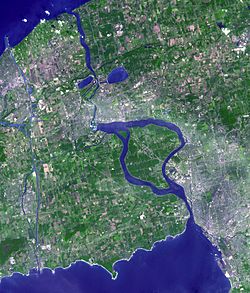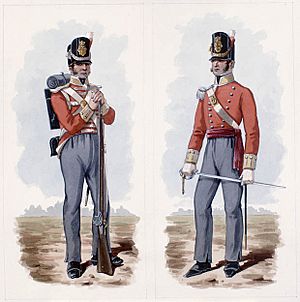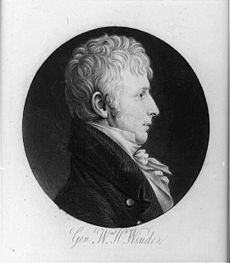Battle of Frenchman's Creek facts for kids
Quick facts for kids Battle of Frenchman's Creek |
|||||||
|---|---|---|---|---|---|---|---|
| Part of the War of 1812 | |||||||
 The Niagara River from above. |
|||||||
|
|||||||
| Belligerents | |||||||
| Commanders and leaders | |||||||
| Cecil Bisshopp | Alexander Smyth | ||||||
| Strength | |||||||
| c. 650 | 770 | ||||||
| Casualties and losses | |||||||
| 13 killed; 44 wounded; 34 captured |
24 killed; 55 (known) wounded; 39 captured |
||||||
The Battle of Frenchman's Creek was a fight during the War of 1812. It happened in the early morning of November 28, 1812. The battle took place in Upper Canada, near the Niagara River. This area is now part of Ontario, Canada.
The Americans planned this attack as a quick raid. They wanted to prepare the way for a bigger invasion. American soldiers successfully crossed the Niagara River. They landed at their planned attack spots. They achieved one of their main goals before leaving. However, the larger invasion was later cancelled. This made their success less important. Canadians called this fight "the Battle of Frenchman's Creek." Americans at the time called it "the Affair opposite Black Rock."
The battle site became a National Historic Site of Canada in 1921.
Contents
Why Did the Battle Happen?
After a loss at the Battle of Queenston Heights, Brigadier General Alexander Smyth took command. He led the U.S. Army on the Niagara Frontier. Smyth quickly planned to invade Canada with 3,000 soldiers. He gathered his forces in Buffalo.
Smyth planned a two-part attack before his main invasion.
- Captain William King and 220 men would cross the Niagara River. Their job was to disable the cannons at the Red House. This would allow Smyth's main force to land safely.
- At the same time, Lieutenant Colonel Charles Boerstler and 200 men would land in Canada. They would destroy the bridge over Frenchman's Creek. This would stop British help from arriving.
The British commander, Lieutenant General Sir George Prevost, had a different plan. He told his forces not to attack first. This meant British soldiers had to wait for the Americans to make a move. They would then try to stop any invasion. British regular soldiers were spread out at different defense points. Local militia and Native American allies joined them.
Smyth published a strong message on November 10. He told the people of New York that his troops would soon "plant the American standard in Canada." He asked New Yorkers to join him. It seems the British across the border did not pay much attention to his message.
Who Fought in the Battle?
Captain William King led the attack on the Red House. He had 150 soldiers from the 12th and 13th U.S. Infantry Regiments. He also had 70 U.S. Navy sailors led by Lieutenant Samuel Angus.
Lieutenant Colonel Charles Boerstler led 200 men from his 14th U.S. Infantry Regiment. They were to attack Frenchman's Creek. Colonel William H. Winder, also from the 14th Regiment, waited in reserve with 350 men.
The local British commander was Lieutenant Colonel Cecil Bisshopp. He was stationed at Chippawa. His forces included soldiers from the 41st and 49th Regiments of Foot. He also had men from the Royal Newfoundland Regiment. Local Lincoln Militia and Norfolk Militia also joined them.
At Fort Erie, there were 80 men from the 49th Regiment. At Black Rock Ferry, there were two companies of Norfolk Militia. At the Red House, 38 men from the 49th Regiment were stationed. They had cannons, including an 18-pounder and a 24-pounder. Further along the road, at Frenchman's Creek, were 38 more men from the 49th Regiment.
The Battle Begins
King's Attack on the Red House
Only some of Captain King's force landed at the Red House. This group included 35 sailors. They faced fire from the British defenders. The Americans charged the British soldiers. The sailors used pikes and swords for close combat. The British pushed them back three times. But King launched a fourth attack. This attack hit the British from the side and overwhelmed them. King's men captured the British commander, Lieutenant Lamont. They also killed or captured most of his soldiers.
The Americans then set fire to the British post. They disabled the cannons. They headed back to their boats to leave. However, it was dark and King's force split up. Lieutenant Angus returned to the landing point. He found only four of the ten boats. Thinking King had already left, Angus crossed the river with his men.
When King's group arrived, they were stranded. They found two British boats downriver. King sent half his men and the prisoners across the Niagara River. He waited with his remaining 30 men for more boats from Buffalo.
Boerstler's Attack on Frenchman's Creek
Lieutenant Colonel Boerstler headed for Frenchman's Creek. But four of his eleven boats could not cross the river. They were either lost in the dark or the rowers were not skilled enough. These boats had to turn back.
Boerstler's seven remaining boats landed. They faced Lieutenant Bartley and his 37 men from the 49th Regiment. Boerstler led the attack. He shot a British soldier who was about to attack him. Bartley's outnumbered force retreated. The Americans chased them to the Frenchman's Creek Bridge. They captured two prisoners.
Then, Captain Bostwick's Norfolk Militia attacked Boerstler's men. After some fighting, the Canadians retreated. Boerstler faced another problem. Many of the tools needed to destroy the bridge were in the boats that turned back. The tools that did make it ashore were left behind. Boerstler sent eight men to break up the bridge. They tore up about a third of the bridge's planks. Then, they learned that the entire British force from Fort Erie was coming. Boerstler quickly got his men back into their boats. They rowed back to Buffalo. He left behind the men who were working on the bridge.
Winder's Reinforcement and Retreat
When General Smyth heard that King had disabled the cannons, he was very happy. "Canada is ours!" he shouted. He sent Colonel Winder with 350 men across the river. Winder's job was to pick up King and his men. Winder collected the men left at the bridge. He then landed his own troops.
However, Winder had only landed part of his force when Bisshopp's 300 British soldiers appeared. Winder ordered his men back to their boats. They rowed away towards Buffalo. As they left, they came under heavy fire. This caused 28 casualties for Winder's force.
By disabling the cannons at the Red House, the Americans had achieved their most important goal. An invading force could now land without facing cannon fire. However, later events made this success useless.
Who Was Hurt?
The British reported 15 killed, 46 wounded, and 30 missing. The Americans captured 34 prisoners. This included Lieutenant Lamont and Lieutenant King. This means the actual British loss was 13 killed, 44 wounded, and 34 captured.
American records show that Captain King's group had 8 killed and 9 wounded. Colonel Winder's group had 6 killed and 22 wounded. The losses for Lieutenant Colonel Boerstler's group were not fully recorded. One report said that 28 of Lieutenant Angus's 35 sailors were killed or wounded. Captain King and 38 other prisoners were captured by the British. The British found 12 American dead at the Red House. In total, 18 American dead were recovered.
It seems that 6 of the dead and 8 of the prisoners belonged to Boerstler's group. So, the known American casualties were 24 killed, 55 wounded, and 39 captured.
What Happened Next?
With the cannons disabled, General Smyth pushed ahead with his invasion plans. But trying to get his 3,000 men onto boats was chaotic. Only 1,200 men could get on board. There were not enough boats, and the cannons took up too much space. It was raining heavily and freezing cold. Smyth and his officers decided to delay the invasion. They needed more time to prepare.
On November 30, Smyth tried again. He ordered his men to board two hours before dawn. This was to avoid enemy fire. But the boarding was very slow. Two hours after sunrise, only 1,500 men were on board. Smyth did not want to land in broad daylight. So, he postponed the invasion again.
By this time, the soldiers' spirits were very low. Discipline had broken down, and the camp was very chaotic. Many soldiers were also sick. Smyth called another meeting. They decided to stop all attacks until the army got more soldiers.
The army then went into winter camps. They did not try any more attacks. General Smyth asked for time off to visit his family. Three months later, President James Madison removed Smyth from the U.S. Army. Smyth did not resign or face a military trial.
The British and Canadians did not know the Americans' true plans. They thought King, Boerstler, and Winder were the first wave of Smyth's main invasion. The Canadian newspapers praised their defenders. They said the defenders had bravely pushed back the Americans. They especially praised Bisshopp. Major General Sir Roger Hale Sheaffe, the British commander, also praised Bisshopp. Bisshopp was killed the next summer while leading another raid.
Seven active U.S. Army infantry battalions today carry on the history of the American regiments that fought at the Battle of Frenchman's Creek.





